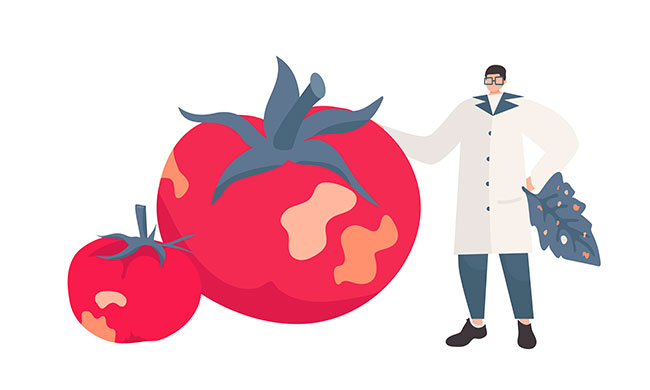
Features
Crop Protection
Research
Disinfectant hopefuls against the rugose
Recent research studies are uncovering potential disinfectants that could be useful against the tomato brown rugose fruit virus.
September 28, 2021 By Dr. Geneviève Marchand, Dante Cacciotti, and Destin Lamondin
 Researchers across the globe are studying the potential for using different disinfectant products against the tomato brown rugose fruit virus.
Photo: © Margarita Cheblokova / iStock / Getty Images Plus
Researchers across the globe are studying the potential for using different disinfectant products against the tomato brown rugose fruit virus.
Photo: © Margarita Cheblokova / iStock / Getty Images Plus Tomato brown rugose fruit virus (ToBRFV, colloquially known as “the rugose virus”) was first reported in Israel in 2014. It mostly represents a threat to greenhouse tomatoes, but also peppers, in Canada and around the world. Infection of plants with the virus may cause symptoms, resulting in fruits being unmarketable or prevented from export. Crop losses have been reported to range from 30 to 100 per cent.
Like other Tobamovirus species, ToBRFV is known to be seed borne and challenging to manage. It is easily transmitted mechanically by anything that comes in contact with the plant (e.g. workers’ hands, tools, etc.), and it is persistent in the environment. Biosecurity remains the main line of defense. Despite recent announcements from various seed companies about tolerant and resistant varieties being developed, resistant tomato varieties suitable for the greenhouse market are not widely available yet.
Recent studies report on the efficacy of disinfectants for eradication of the virus, and should be of interest to growers.
Handwashing
For handwashing, a study from the United Kingdom has demonstrated that the virus can survive on the surface of gloved hands for up to 120 minutes (maximum duration tested). Only one tested product, Nzym Rugo, was found to be efficacious for handwashing after one minute of contact time. However, this product is not currently available in Canada. For this reason, it is currently suggested that workers wear gloves and change them frequently.
Surface disinfection
For surface disinfection, studies by the same group of British researchers have shown that the virus can survive for weeks to months on greenhouse surfaces (glass, concrete, aluminum, hard plastic, polyethylene and stainless steel). Four of the six disinfectant products tested – Huwa San, Menno Florades, bleach and Virkon – were partially to fully efficacious on most surfaces after 60 minutes of contact time. But this duration may be challenging to achieve or not possible for certain applications (for example, footbaths).
A recently published study by researchers from the United States Department of Agriculture investigated the efficacy of additional disinfectant products. Three products – bleach, Virocid, and lactoferrin – proved highly efficacious at inactivating the virus in test tubes, with a short contact time of at most 60 seconds. Five additional products – Virkon, trisodium phosphate, Lysol, Virex, and SP 2700 – also showed some efficacy even with this short contact time.
Seed disinfection
Two recent studies also evaluated various protocols for seed disinfection.
In the first study by researchers from Italy, three thermal treatments and three chemical treatments inactivated the virus at least partially, without affecting seed germination significantly. Those chemical treatments with either trisodium phosphate or sodium hypochlorite (active ingredient in bleach) appeared particularly efficacious.
In the second study by collaborating researchers from Italy and Jordan, treatment with hydrochloric acid or sodium triphosphate resulted in full inactivation of the virus, without negative impacts on seedlings.
Check first
Disinfection is a key part of ToBRFV management in the greenhouse. As research on the virus continues around the world, the list of potential disinfecting agents will continue to grow.
It’s important that growers confirm whether particular products and protocols are approved for greenhouse use. Not all of the products mentioned here are available or registered as greenhouse disinfectants in Canada. Differing formulations and concentrations could change the outcome and even pose a risk to the crop.
Growers interested in the products and protocols mentioned here are encouraged to discuss them with local extension specialists and seed providers.
References
Samarah, N. et al. (2020) Disinfection treatments eliminated tomato brown rugose fruit virus in tomato seeds. Eur J Plant Pathol https://doi.org/10.1007/s10658-020-02151-1
Davino, S. et al. (2020) Tomato Brown Rugose Fruit Virus: Seed transmission rate and efficacy of different seed disinfection treatments. Plants 9, 1615; doi:10.3390/plants9111615
Geneviève Marchand, PhD, is a research scientist and plant pathologist at Agriculture and Agri-food Canada, stationed at the Harrow Research and Development Centre in Ontario. Dante Cacciotti and Destin Lamondin are students at Niagara College.
This is one in a series of research updates, written in collaboration with students in the Hort1346 Greenhouse Production Course at Niagara College and initiated by instructor Sebastien Jacob.
Print this page